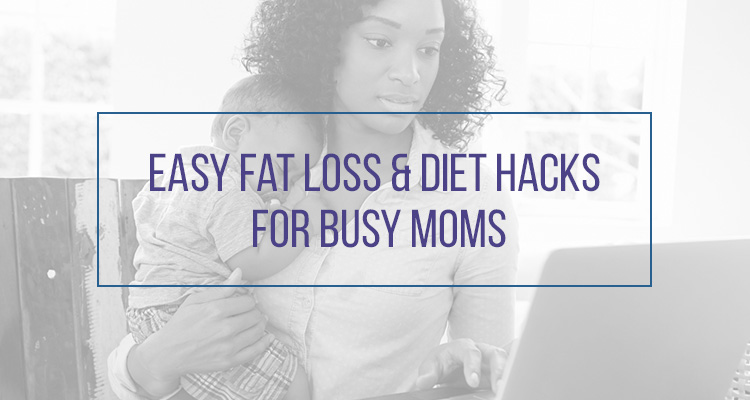
Having a baby changes everything.
Suddenly, all aspects of your day, even your sleep, revolve around a beautiful new child. But raising children creates packed schedules, making it hard for parents to plan healthy meals or schedule workouts into their routine.
It’s hard to find a moment for yourself as you navigate motherhood. For many moms, losing weight seems like an impossible addition to an already full schedule. But improving your health doesn’t have to be difficult.
In this article, we’ll explore simple changes you can make to your daily routine to kick-start your weight loss journey. These easy choices will help you lose weight and have the energy to fully enjoy this new chapter of your life.
EAT BREAKFAST, EVEN IF YOU’RE BUSY
Reducing your daily caloric intake is a key factor in weight loss — to lose weight, you must be in a small caloric deficit so your body will burn stored fat as fuel.
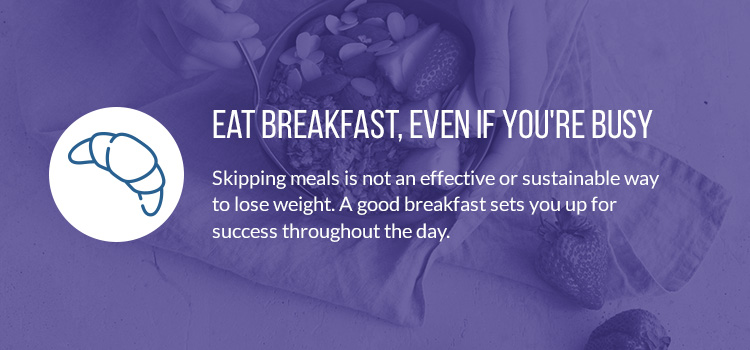
Skipping breakfast may look like the perfect answer — swapping scrambled eggs for coffee or juice seems like an easy way to cut calories. But skipping meals is not an effective or sustainable way to lose weight.
A good breakfast sets you up for success throughout the day. If you are starving by the time lunch comes, you are less likely to choose healthy, nutritional foods. Most likely, skipping breakfast means that you’ll experience stronger cravings throughout the day, making it more difficult to make good choices for your body.
Research suggests that opting out of a morning meal won’t help you lose fat — contrary to popular belief, eating a good breakfast is one of the unifying habits of people who lose weight and keep it off for the long-term.
Try making breakfast your largest meal instead of dinner, as is typical with many American diets. When you pack in calories early in the day, your body has longer to burn them as fuel — your body will use breakfast calories as energy for the day.
If you’re short on time in the mornings, you could make breakfast the night before. Overnight oats or smoothie freezer packs are quick and easy to prepare, and pre-planned breakfasts take less energy to make in the morning. If you don’t have time to make food the night before, try scrambling a couple of eggs and pairing with some fresh fruit. Not only is this breakfast filling, but it takes under 10 minutes to prepare.
DON’T FINISH FOOD FOR YOUR KIDS
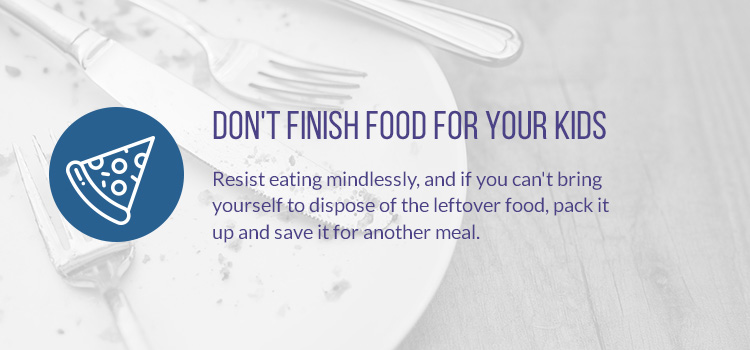
Surprisingly, we can all learn by watching the way a toddler or young child eats.
First, young children eat while sitting in a designated place. We buckle toddlers into high chairs while they eat, which is an important lesson for all of us. Sitting still for meals promotes concentration and allows you to better monitor what you’re eating and how much. It also helps you feel more full, leading to less snacking throughout the day.
Kids also don’t eat distractedly. Instead of multitasking through a meal, focus on eating. You’ll probably find that you eat less and get full faster. This might mean cutting out screens during lunch, which are known to trigger mindless eating. If you eat lunch at work, leave your desk during meals for a change of scene. At home, avoid doing other things while eating. Instead, treat mealtimes as a moment of personal time. Take a few minutes to yourself, breathe, and enjoy the food you’ve prepared — you’ve earned it.
Your child also has no problem saying no to food. When they are full, they push their plate away, even if this means there’s food left on the dish. But adults often eat even when they’re stuffed, either out of boredom or to avoid wasting any food. Many parents find themselves finishing up their child’s leftover food to avoid throwing away food.
But finishing your kid’s plate for them means taking in extra calories, which can add up quickly when you’re trying to lose weight. Instead, imitate your child — resist eating mindlessly, and if you can’t bring yourself to dispose of the leftover food, pack it up and save it for another meal.
DRINK MORE FLUIDS
Proper hydration is essential for weight loss.
But not all liquids are helpful for nutrition and losing weight. Sodas, even diet brands, are filled with sugar, synthetic chemicals and caffeine, which can sabotage your weight loss journey.
Fruit juice might seem like the perfect alternative to soda. But although juice is marketed as healthy, it is also filled with immense amounts of sugar and just as many calories as soda. The high sugar content paired with low amounts of fiber leads to a spike in blood sugar. Ultimately, most bottled drinks add empty calories to your day without giving you any true health benefits.
Instead, focus on drinking water. Water has been shown to boost your metabolism, helping you burn fat throughout the day. Drinking enough water also helps you know what cravings are actually motivated by hunger — often, we interpret a need for fluid as a need for food. Water keeps you full between meals, and helps you eat less during meals. Water also powers your workouts, helping you stay active for longer.
But water doesn’t have to be boring. Seltzer water gives you the feeling of carbonated drinks without the sweeteners, and it comes in a variety of fun and unique flavors. Try adding a splash of lemon to your water for a hint of sweetness that reduces bloating, or infuse your water with soothing natural flavors like cucumber and mint.
If you struggle to drink enough water during the day, try adding a cup of tea to your early morning or after dinner routine. However, avoid teas marketed as “weight loss” supplements — often, they contain harmful ingredients that will hurt your digestive system, and they won’t help you lose weight in the long term. Instead try sipping green tea, a natural source of antioxidants that has been proven to boost your metabolism.
CONFINE FOOD TO THE KITCHEN
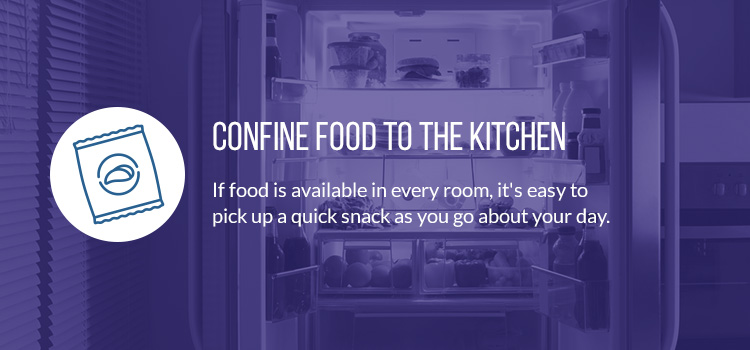
An easy way to reduce mindless eating is to keep all food in the kitchen or pantry.
Snacks in the bedroom, living room or office desk make it more challenging to resist snacking throughout the day. One study found that overweight participants were more likely to store food in places other than the kitchen, which is understandable — if food is available in every room, it’s easy to pick up a quick snack as you go about your day.
But these extra calories can quickly add up. Snacking throughout the day has been linked to weight gain, tooth decay and other negative health repercussions. By keeping your food in one place, eating becomes a mindful choice. Every snack requires you to walk to the kitchen, which means you’re more likely to eat when truly hungry instead of snacking on cravings.
If you need a few snacks on hand, it’s possible to store strategic, healthy snacks and still achieve your health goals. For example, if you want to keep snacks in your car for emergencies, stick to nutritious options such as egg white chips or home-made trail mix. Store these snacks in a hard-to-reach place where you can’t easily grab them as you drive. This way, if you get hungry in the middle of a long errands run, you have a healthy option available to keep you going until a meal.
PLAY WITH YOUR KIDS
Playtime can be a welcome moment of peace in a hectic day. While your kids play, it’s tempting to sit back and rest.
But choosing to be active with your kids not only keeps you moving, but it also builds precious memories and strengthens your bond. Instead of sitting back on the couch, when your kids begin to play, start playing with them.
When your child is young, this might mean creatively incorporating them into short workouts. Jump into a 30-second plank as your toddler crawls around the floor, or hold them and make silly faces as you do a few crunches. When your kids are old enough to play outside, chase them around the backyard or take them to a nearby park. A park playground is a perfect impromptu gym — while watching them play, try a few tricep dips on a bench or do some fast step-ups on the equipment stairs.
Self-care is essential for your overall health, and it can be appropriate to rest while your kids play. But try to spend the majority of playtimes on the floor with your toddler or outside with your child, at least for 20 or 30 minutes. This short time investment on your part shows your child that you enjoy spending time with them, and it can help you reach your daily activity goals without committing to a gym membership.
BE CONSCIOUS OF PORTION SIZES
Americans have notoriously large portion sizes.
Today, the average American plate and portion sizes are significantly larger than they were a few decades ago, leading to a 20 to 25 percent increase in daily caloric intake per person. In the 1980s, the average serving of French fries was about 210 calories. Today, the average serving has around 610 calories. Just 20 years ago, two slices of pizza were roughly 500 calories, but today, the caloric count is closer to 850.
Large portions lead to consuming more food — reducing portion size is an easy way to cut back on calories. Research correct portion sizes, perhaps comparing them to common everyday objects. This will help you visualize correct portions, whether you are at home or a restaurant.
When eating out, ask for a to-go box after the waiter brings your meal to the table. Before you eat, put roughly half of the meal away in the box — most likely, you will feel full after just eating half the portion. Removing half the food beforehand ensures you don’t mindlessly eat what’s in front of you.
For at-home meals, try eating off of smaller plates. The plate will fill up quickly, making the serving size look larger and keeping you from overeating. Another easy trick to reduce portions is to keep your food in the kitchen during a meal — have each family member serve themselves before sitting down. This keeps food off of the table, discouraging mindless eating during dinner.
STOCK UP ON HEALTHY FOOD AND MAKE THEM VISIBLE
The best way to prime yourself for success is to eliminate or hide sugary foods and make healthy foods visible.
Keeping unhealthy food visible may actually increase your cravings, which can lead to weight gain. If healthy foods are around and available, you’re much more likely to choose them when you’re hungry. For the same reason, keeping unhealthy options in hard-to-reach locations makes you less likely to spend the time and energy reaching them when you’re looking for a quick snack.
This might mean that you dedicate one evening a week to preparing food for the week. You can find endless recipes for quick and healthy prepare-ahead meals, including ones specifically designed for busy moms. Having meals ready in the fridge will save time during the week, and will make choosing a healthy meal an easy decision.
When you’re shopping for groceries, avoid choosing foods you don’t like just because they are healthy. If you have never liked carrots, don’t keep bags of them in the fridge — you most likely won’t eat them, and you could feel guilty when they go bad. Instead, focus on healthy foods that you love — if sweet potatoes or broccoli are some of your favorite foods, keep them stocked in your pantry.
SET ACHIEVABLE GOALS
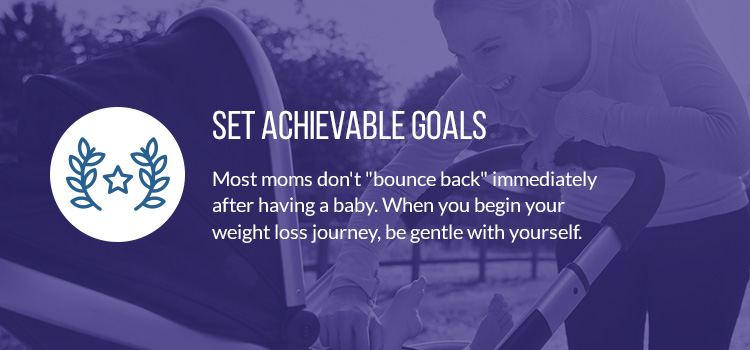
One of the top mistakes new moms make when trying to lose weight is setting unrealistic goals.
Most moms don’t “bounce back” immediately after having a baby. Pregnancy and childbirth are hard on your body, and it takes time to regain your pre-pregnancy energy or weight.
When you begin your weight loss journey, be gentle with yourself. One way to set yourself up for success is to focus on achievable goals.
Start by setting mini-goals, like going for a 30-minute walk with your baby five days a week. Maybe you would like to reduce sugar in your diet. Instead of cutting all sugar out immediately, start by avoiding it two days a week. As your body adjusts to less sugar, slowly increase the days you avoid it.
After you meet your small goal for one or two weeks in a row, let yourself enjoy a reward you love, like a bouquet of flowers or a movie night.
As you work towards meeting your small goals, keep the big picture in mind — while you may not lose 20 pounds in 12 weeks, by making small changes, you set yourself up for long-term, sustainable success.
LET ZERONA HELP YOU REACH YOUR FAT LOSS GOALS
When you have a child, it’s easy to forget about yourself. But self-care is essential for a balanced life, whether that means regular spa days or the occasional night away. One of the best ways to invest in yourself after becoming a mother is to focus on your health.
Sometimes, we need a little extra help in reaching our goals. If you are looking for a quick, effective treatment to supplement your exercise and nutrition regimes, consider non-invasive body contouring. Zerona Z6 low-level laser therapy (LLLT) has been shown to reduce inches by stimulating and shrinking fat cells. Besides slimming down your figure, LLLT increases your cellular metabolism, improving your overall health. Because LLLT is non-invasive, clients have a milder and faster recovery, and the results are consistent over the long-term.
Learn more about non-invasive laser therapy, find a provider or talk to one of the Zerona expert team members today to figure out the best option for you and your body.
